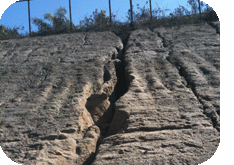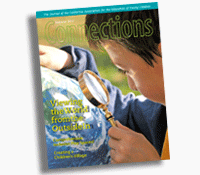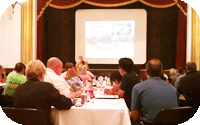Effective Erosion Control Using Turf Reinforcement Mats
Author: Chad Kennedy, Landscape Architect, ASLA
 The erosive forces of nature can be observed all around us. A young child recognizes them during sand play at the beach, students learn about them in physical sciences and geology courses, and home and land owners cringe as wind, rivers and waves slowly eat away at their investments. We have all been exposed to the erosive powers of nature to some degree. What most of us have not been exposed to however, are effective methods that can be used when we attempt to control and minimize the movement of soil. In general terms there are three modern methods of erosion control available: natural vegetation of slopes, reinforced vegetation and hard armor (rip rap/concrete). Each method has its pros and cons as well as limitations. Turf reinforcement mats (TRM) are effective modern forms of reinforced vegetation that deserve closer examination.
The erosive forces of nature can be observed all around us. A young child recognizes them during sand play at the beach, students learn about them in physical sciences and geology courses, and home and land owners cringe as wind, rivers and waves slowly eat away at their investments. We have all been exposed to the erosive powers of nature to some degree. What most of us have not been exposed to however, are effective methods that can be used when we attempt to control and minimize the movement of soil. In general terms there are three modern methods of erosion control available: natural vegetation of slopes, reinforced vegetation and hard armor (rip rap/concrete). Each method has its pros and cons as well as limitations. Turf reinforcement mats (TRM) are effective modern forms of reinforced vegetation that deserve closer examination.
 What is a TRM? A turf reinforcement mat (TRM) is a hybrid erosion control method that combines a long-term synthetic control method with the benefits of natural vegetation to create a high-strength matting or cover for soil surfaces. TRMs are typically made of geosynthetic materials (polypropylene, nylon, pvc) and are either woven and stitched into patterns or extruded in random patterns to create porous mats with varied thicknesses and heights. The designs are intended to provide rigid frameworks for holding seeds in place longer (improving germination rates), establishing consistent vegetative stands, and promoting a solid base for plant root protection against erosive forces. It is important to note that TRMs are not temporary erosion control methods like erosion control blankets or jute netting, they are meant to be permanent installations. TRMs alone are not usually considered viable erosion control methods, though there are high performance turf mats on the market that may be used without over-seeding in some situations and on certain types of projects.
What is a TRM? A turf reinforcement mat (TRM) is a hybrid erosion control method that combines a long-term synthetic control method with the benefits of natural vegetation to create a high-strength matting or cover for soil surfaces. TRMs are typically made of geosynthetic materials (polypropylene, nylon, pvc) and are either woven and stitched into patterns or extruded in random patterns to create porous mats with varied thicknesses and heights. The designs are intended to provide rigid frameworks for holding seeds in place longer (improving germination rates), establishing consistent vegetative stands, and promoting a solid base for plant root protection against erosive forces. It is important to note that TRMs are not temporary erosion control methods like erosion control blankets or jute netting, they are meant to be permanent installations. TRMs alone are not usually considered viable erosion control methods, though there are high performance turf mats on the market that may be used without over-seeding in some situations and on certain types of projects.
The Benefits of TRMs: Turf reinforcement mats are an effective marriage of hard armor and natural vegetation erosion control benefits. The benefits of hard armor are longevity, low maintenance requirements and capability to handle high velocities and shear stresses. This method is very costly however and often cost prohibitive. The benefits of a natural vegetation methods are low initial cost, simple installation, aesthetics, high permeability and improved water quality and wildlife habitat. Natural vegetation however, may not establish well on steep slopes, can be washed out easily in high flow events, must be maintained regularly and can be damaged easily by high shear stresses.
TRMs, when seeded, on the other hand, can have most of the benefits associated with both hard armor and natural vegetation. When installed properly they have very high velocity and sheer stress tolerances (see the graphic above), long-term material longevity, relatively low material and installation cost, aesthetic appeal, high permeability, stormwater cleansing properties and wildlife habitat value. The benefits associated with a TRM are contingent, however, on appropriate installation, timing, and plant species selection, all required for establishment of a healthy solid stand of vegetation.
 Applications for TRMs: Turf reinforcement mats have been used across the nation by the Army Corps of Engineers, transportation departments, municipalities and private developers to minimize the loss of soils. A few of the many possible applications for TRMs include:
Applications for TRMs: Turf reinforcement mats have been used across the nation by the Army Corps of Engineers, transportation departments, municipalities and private developers to minimize the loss of soils. A few of the many possible applications for TRMs include:
- Water channels / canals / conveyance structures
- Pipe inlets and outlets
- Shorelines and riverbanks
- Municipal retention and detention ponds
- Levees, dams and dikes
- Steep slopes and grades
Turf Reinforcement mats are just one of many methods for erosion control and not one will be the right solution for every project. Consultation with a design professional about the available options and the most appropriate method for your site should be the first step. Contact us with any questions or inquiries you may have or for additional information.
 The erosive forces of nature can be observed all around us. A young child recognizes them during sand play at the beach, students learn about them in physical sciences and geology courses, and home and land owners cringe as wind, rivers and waves slowly eat away at their investments. We have all been exposed to the erosive powers of nature to some degree. What most of us have not been exposed to however, are effective methods that can be used when we attempt to control and minimize the movement of soil. In general terms there are three modern methods of erosion control available: natural vegetation of slopes, reinforced vegetation and hard armor (rip rap/concrete). Each method has its pros and cons as well as limitations. Turf reinforcement mats (TRM) are effective modern forms of reinforced vegetation that deserve closer examination.
The erosive forces of nature can be observed all around us. A young child recognizes them during sand play at the beach, students learn about them in physical sciences and geology courses, and home and land owners cringe as wind, rivers and waves slowly eat away at their investments. We have all been exposed to the erosive powers of nature to some degree. What most of us have not been exposed to however, are effective methods that can be used when we attempt to control and minimize the movement of soil. In general terms there are three modern methods of erosion control available: natural vegetation of slopes, reinforced vegetation and hard armor (rip rap/concrete). Each method has its pros and cons as well as limitations. Turf reinforcement mats (TRM) are effective modern forms of reinforced vegetation that deserve closer examination.  What is a TRM? A turf reinforcement mat (TRM) is a hybrid erosion control method that combines a long-term synthetic control method with the benefits of natural vegetation to create a high-strength matting or cover for soil surfaces. TRMs are typically made of geosynthetic materials (polypropylene, nylon, pvc) and are either woven and stitched into patterns or extruded in random patterns to create porous mats with varied thicknesses and heights. The designs are intended to provide rigid frameworks for holding seeds in place longer (improving germination rates), establishing consistent vegetative stands, and promoting a solid base for plant root protection against erosive forces. It is important to note that TRMs are not temporary erosion control methods like erosion control blankets or jute netting, they are meant to be permanent installations. TRMs alone are not usually considered viable erosion control methods, though there are high performance turf mats on the market that may be used without over-seeding in some situations and on certain types of projects.
What is a TRM? A turf reinforcement mat (TRM) is a hybrid erosion control method that combines a long-term synthetic control method with the benefits of natural vegetation to create a high-strength matting or cover for soil surfaces. TRMs are typically made of geosynthetic materials (polypropylene, nylon, pvc) and are either woven and stitched into patterns or extruded in random patterns to create porous mats with varied thicknesses and heights. The designs are intended to provide rigid frameworks for holding seeds in place longer (improving germination rates), establishing consistent vegetative stands, and promoting a solid base for plant root protection against erosive forces. It is important to note that TRMs are not temporary erosion control methods like erosion control blankets or jute netting, they are meant to be permanent installations. TRMs alone are not usually considered viable erosion control methods, though there are high performance turf mats on the market that may be used without over-seeding in some situations and on certain types of projects.
 Applications for TRMs: Turf reinforcement mats have been used across the nation by the Army Corps of Engineers, transportation departments, municipalities and private developers to minimize the loss of soils. A few of the many possible applications for TRMs include:
Applications for TRMs: Turf reinforcement mats have been used across the nation by the Army Corps of Engineers, transportation departments, municipalities and private developers to minimize the loss of soils. A few of the many possible applications for TRMs include:

 The event was a great success and the O'Dell team had a great time putting it on! Thank you to all who were able to attend. There were over 80 attendees from all over Northern California, representing many professions including: public works staff,parks and recreation staff,risk managers, inclusive play advocates, landscape architects, educators, and more!
The event was a great success and the O'Dell team had a great time putting it on! Thank you to all who were able to attend. There were over 80 attendees from all over Northern California, representing many professions including: public works staff,parks and recreation staff,risk managers, inclusive play advocates, landscape architects, educators, and more!